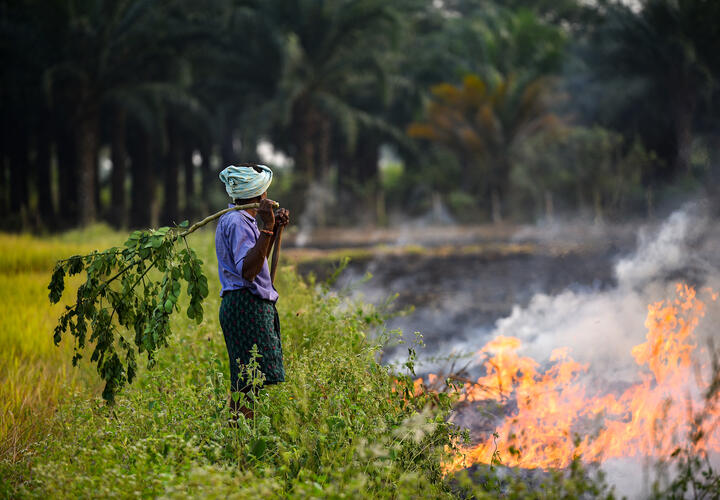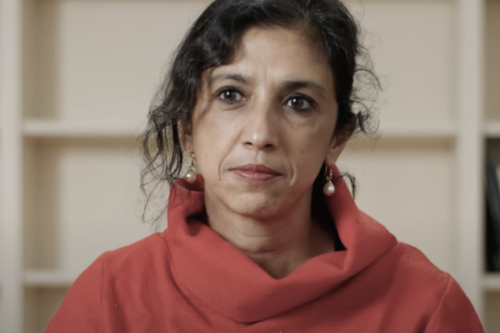Rohini Pande and coauthors in VoxDev: Evidence from payments to reduce crop burning in India
March 28, 2023: EGC affiliate Rohini Pande, and coauthors Kelsey Jack, Seema Jayachandran, and Namrata Kala discuss existing evidence on payments to reduce crop residue burning in India.

Programmes that pay farmers not to burn crop residue face challenges with compliance, but contracts that include partial upfront payments can help
By Kelsey Jack, Seema Jayachandran, Namrata Kala, and Rohini Pande
This article first appeared in VoxDev on March 28, 2023
Poor air quality is a growing problem worldwide and is a leading preventable cause of death and illness (Fuller et al. 2022). In particular, air pollution reduces the life expectancy of North India’s roughly half a billion residents by up to seven years (Lee and Greenstone 2021). One of the major sources of this pollution in this region is crop burning – the practice of using fires to clear agricultural land after harvest. Since 2015, farmers in North India have faced bans on burning the residue of crops, and the government has subsidised machines to remove and manage it. However, these policies have not resulted in large reductions in burning.
In a new study, we test refinements to a contract system called Payments for Ecosystem Services (PES), which gives out cash transfers conditional on undertaking environmentally friendly practices. PES has two advantages over current approaches. First, these policies are more politically feasible than fines or other penalties. Second, unlike equipment subsidies that attempt to change input, they incentivise improvements in outcome. However, contract design is potentially important in PES programmes, which (like other conditional cash transfer contracts) may get lower compliance due to farmers facing liquidity constraints or not trusting that the conditional payment will be made once they comply. We test whether contracts set up to alleviate such constraints impact contract efficacy.
Yale video features Rohini Pande on political economy research, and women's access to opportunities

May 5, 2022: As part of the YaleCampus video series on the Faculty of Arts and Sciences, Pande describes a large-scale study in India studying the effects of increasing women's access to mobile technology.
The economic impact of crop residue burning
A recent study estimates that crop residue burning caused 86,000 premature deaths in India in 2018, with over half of the deaths due to paddy (i.e. rice) residue burning in the state of Punjab (Lan et al. 2022). Roughly 4 million acres of paddy residue were burned in Punjab in 2018. Using $700,000 as the value of a statistical life (Majumder et al. 2018), the average mortality costs per acre of burning are $8,000. In comparison, paddy production generates about $500 per acre in revenue. This suggests that eliminating residue burning would almost certainly increase societal welfare.
Payments for Ecosystem Services (PES) in Punjab, India
In Jack et al. (2022), we test the importance of contract design in improving compliance with PES programmes. To alleviate constraints such as liquidity (which implies farmers will not have cash prior to be being paid to rent equipment to manage crop residue), or trust (they do not trust that the conditional portion of the payment will materialise), we vary both the total (conditional) amount offered, as well as the proportion of payment that is paid upfront (unconditionally). If upfront payments are effective in alleviating liquidity and/or trust constraints, they may be more effective than standard contracts. However, since the marginal (conditional) payment for compliance is lower in these contracts, they may reduce compliance.
The experiment
We conducted a randomised controlled trial in 171 villages in the Indian state of Punjab during the 2019 rice-growing (kharif) season to compare the efficacy of standard PES and partial upfront PES. We compare three farmer groups: those who did not receive a contract (control), those who received a contract with payment conditional on verification that the farmer did not burn (standard PES), and those who received a contract with a partial upfront payment that was (explicitly) unconditional on compliance, with the remainder conditionally paid after verification (upfront PES). The standard PES arm comprised two treatment arms. The first offered farmers 800 rupees per acre to comply, and the second, 1600 rupees per acre. The upfront payment arm also comprised two treatment arms: the first offered farmers 800 rupees per acre to comply, of which 200 was paid upfront; and the second, 800 rupees per acre, 400 upfront.
Measuring impact of PES on crop burning
We measured how PES impacted crop burning using multiple data sources. First, we used contract compliance data to understand if farmers that were monitored participated in burning or not. Second, we used remote sensing measures that construct a predicted measure of not burning for all farmers. Third, we used data from our endline survey on measures of crop residue management including primary alternatives to crop burning, which are agricultural implements that either remove residue from the field (ex-situ) such as balers, or directly seed the next crop into the residue (in-situ), such as Happy Seeders (no-till planters towed behind tractors).
Findings
Take-up of PES contract offers: Take-up of PES contracts was high, with around 72% of farmers in both treatment arms signing the contract. Farmers given initial advance did not show higher take-up, possibly due to the fact that the initial advance was not offered at the time of the contract offer (it was disbursed in two to three days once their bank account information has been processed).
Reduction in crop burning and use of alternatives: Offering part of the PES transfer in advance led to significant reduction in crop burning (using satellite imagery to measure burning). Relative to the control group, upfront PES reduced burning by 8 to 11.5 percentage points. In contrast, the effects of standard PES relative to the control group is indistinguishable from zero. This shows that altering the design of standard conditional cash transfers has important implications for the efficacy of the contract.
The reduction in burning is largely matched by an increase in the use of ex-situ management equipment (namely, balers) in the upfront contract arm, increasing by about 9.5 percentage points relative to the control group. There is no increase in the use of ex-situ equipment, which is more expensive on average, reflecting farmers’ preferences for the use of ex-situ management techniques in this setting.
Programme costs and benefits
To evaluate the cost-effectiveness of PES programmes, we compare PES costs with the benefits of reduced residue burning. Despite non-compliance from a substantial portion of farmers paid upfront, the estimated cost of the programme is drastically lower than our rough per-acre mortality benefit estimate ($8,000).
Conclusion
These results show that crop residue burning can be reduced through well-designed PES payments. Our design, which takes institutional constraints and farmer concerns into account, can significantly improve efficacy. Providing a portion of the contract payment upfront results in larger reductions in burning than providing the entire payment after participants have completed costly behaviour change. Despite higher “wasted” payments (to farmers who continue to burn), PES with upfront payments is still cost-effective. It results in burning reductions that provide benefits far in excess of their cost.
PES programmes provide reasons for optimism. They are appealing because they can be implemented by organisations that want to reduce fires but lack the authority to levy fines. Furthermore, the need for upfront payments might become less important as trust in being paid grows over time. The enormity of the environmental risks justifies an investment in PES and other programmes to reduce crop residue burning in India – and in understanding how to make them work for farmers.
References
Fuller, R, P J Landrigan, K Balakrishnan, G Bathan, S Bose-O’Reilly, M Brauer, J Caravanos, T Chiles, A Cohen, L. Corra, M Cropper, G Ferraro, J Hanna, D Hanrahan, H Hu, D Hunter, G Janata, R Kupka, B Lanphear, M Lichtveld, K Martin, A Mustapha, E Sanchez-Triana, K Sandilya, L Schaefli, J Shaw, J Seddon, W Suk, M M Téllez-Rojo, and C Yan (2022), “Pollution and health: a progress update”, The Lancet Planetary Health 6(6): e535-e547.
Jack, B K, S Jayachandran, N Kala, and R Pande (2022), “Money (Not) to Burn: Payments for Ecosystem Services to Reduce Crop Residue Burning”, Working Paper.
Kumar, P, S K Rajpoot, V Jain, S Saxena, Neetu and S S Ray (2019), "Monitoring of rice crop in Punjab and Haryana with respect to residue burning." The International Archives of Photogrammetry, Remote Sensing and Spatial Information Sciences 42: 31-36.
Lan, R, S D Eastham, T Liu, L K Norford and S R H Barrett (2022), "Air quality impacts of crop residue burning in India and mitigation alternatives." Nature Communications 13(1): 6537.
Lee, K and M Greenstone (2021), “Air Quality Life Index annual update”, Technical report, Energy Policy Institute at the University of Chicago.
Majumder, Agamoni, and S. Madheswaran (2018), “Value of statistical life in India: A hedonic wage approach.” Institute for Social and Economic Change.